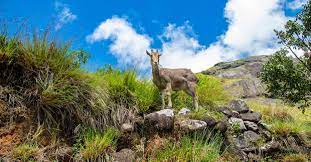What are the endangered animals in Eravikulam National Park?

There is a rise in the Nilgiri tahr numbers in Eravikulam National Park. The annual census held in April sighted 803 tahrs inside the park compared to 785 last year
The Nilgiri tahr is an endangered mountain goat found only in the hill ranges of the Western Ghats in Kerala and Tamil Nadu.
People visiting the Eravikulam National Park (ENP) near Munnar are often amazed to see Nilgiri tahrs grazing nonchalantly in the tourism zone. Most of the park is out of bounds for visitors except for this demarcated area. Here the tahrs are almost tame, even allowing tourists to come close and click pictures!
In stark contrast, the tahrs in the core area of the park, where only park staff and researchers are allowed to go, are extremely shy, fleeing at the sight and sound of humans.
It is said that the tahr in the tourism zone became accustomed to people because of Walter Mackay, the manager of the Rajamalai tea estate in the 1950s. The estate was situated inside the present sanctuary (it was declared a wildlife sanctuary in 1975 and a national park in 1978). Mackay would toot his cars horn while driving through the sanctuary, attracting herds of tahrs. They would mob his car to be rewarded with handfuls of biscuits!
Of course, visitors today are forbidden to feed and pet the tahrs.
The tahr feeds on a variety of herbs, shrubs and grass. Sure-footed and agile like others of its kind, it can negotiate sheer cliffs with amazing ease.
The Nilgiri tahr is endemic to the open grasslands in the upper reaches of the Western Ghats. It is found mainly in the Nilgiri the Anaimalai and Nelliyampathy hill ranges. A mature male tahr has a coat of deep brown and is called a saddleback for the broad swathe of lighter-coloured fur down its back. The females are smaller and lighter in colour. Both have horns that curve straight back.
In the Eravikulam National Park (ENP), the leopard is its only known predator.
The females and juveniles stay close together in a herd. sometimes numbering over a hundred. The males are usually loners and join the herd during breeding time. The females calve from January to February. The park is closed to tourists at this time
There are around 800 tahrs in the ENP and small numbers in the Parambikulam Tiger Reserve and Silent Valley National Park in Kerala. The tahr is also found in Tamil Nadu's Anaimalai hills. Around 60% of tahr habitat in the Western Ghats could be lost to climate change from the 2030s onwards. There are only around 3,120 tahrs left in the wild.
Back from the brink
In the early 1950s, poachers hunted the tahrs (their meat was a much sought-after delicacy) to the point of extinction. The tea company that then owned the area stepped in and declared it a sanctuary. A check post was set up at the site of the present Forest Department outpost, and all vehicles passing through the area were searched for firearms, snares and tahr carcasses. This went a long way in stamping out poaching.
Munnars High Range Wildlife and Environment Preservation Association is an NGO set up in 1928 by conservation-minded British tea planters.
Even today, tea and coffee planters in south India are actively involved in conservation and the Nilgiri tahr is a symbol of their success.
Picture Credit: Google